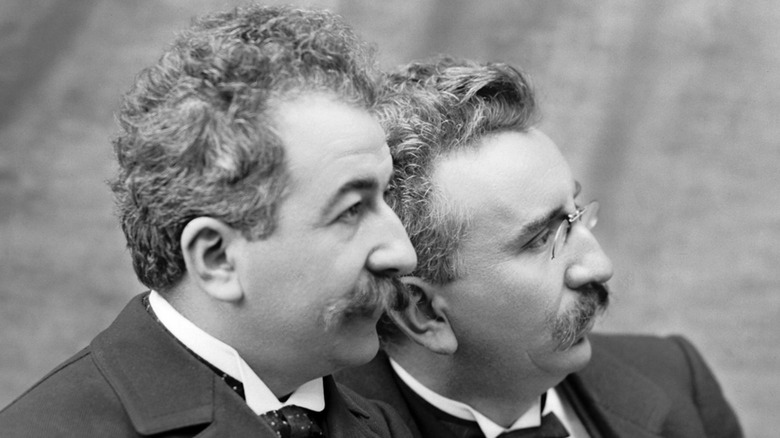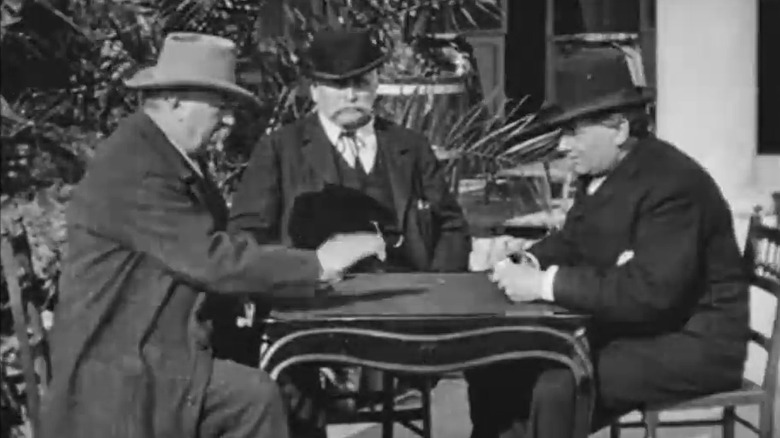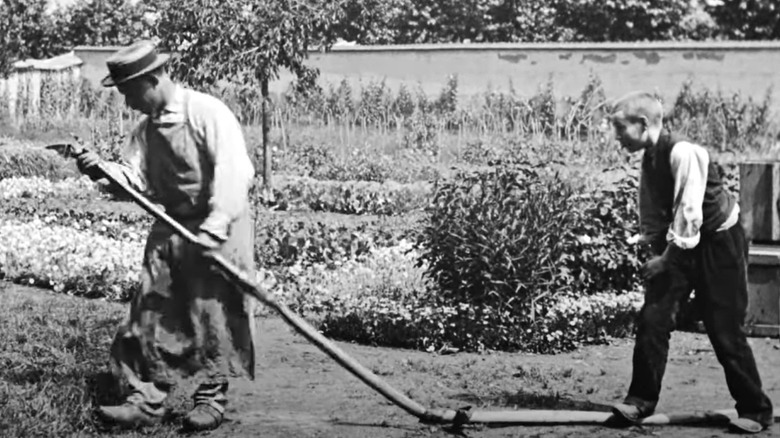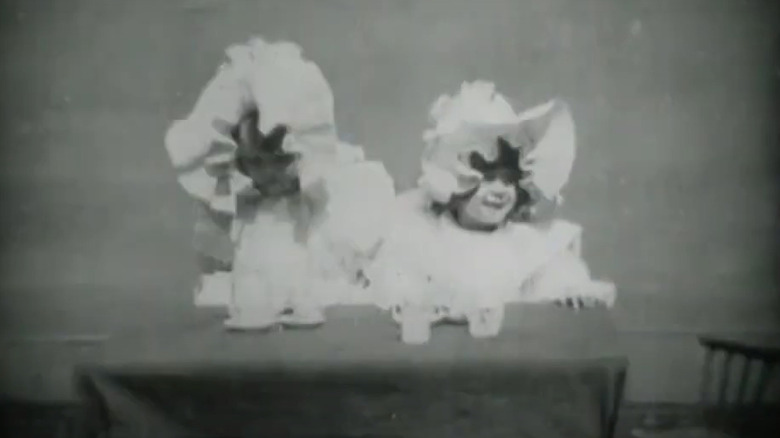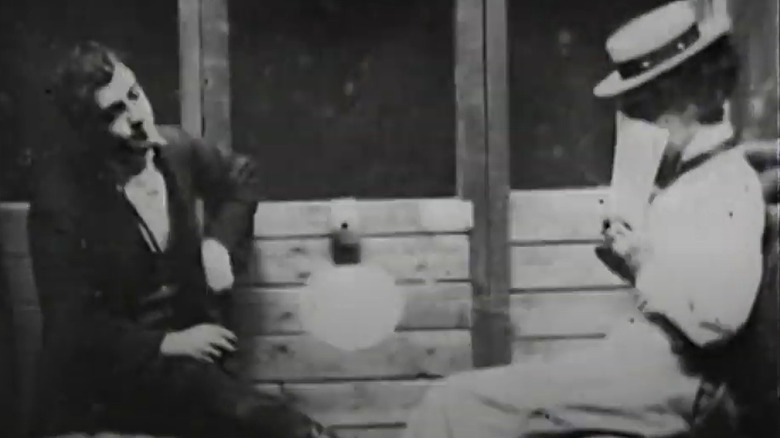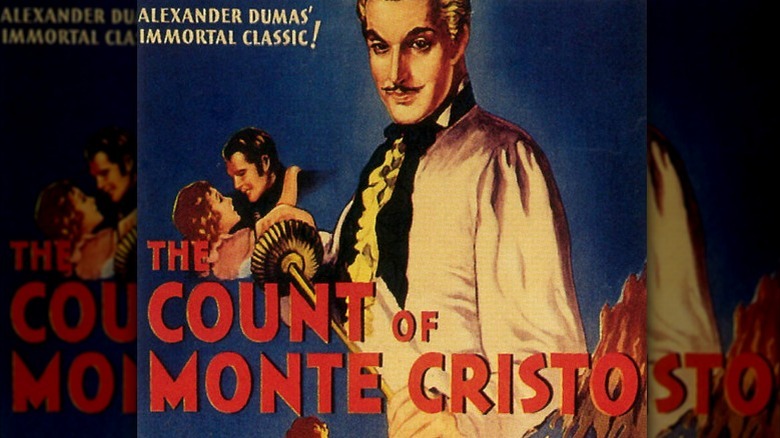The First Movie Remakes Were A Lot Earlier Than You Think
It's very easy for film fans to point to the near-constant remakes of beloved movies as proof of the lack of originality in Hollywood. It's an argument that's not without merit, as there have definitely been plenty of movies that were so good that even their reimaginings couldn't live up to them, even with the benefit of bigger budgets and A-list casts. However, the argument has plenty of exceptions; there's no shortage of remakes that were just as good as — if not better than — the originals.
But no matter one's opinion on the value of modern filmmakers trying their hand at updating a classic film, there's no denying the fact that remaking movies is actually a practice that spans further back in time than you might have realized. In fact, it's almost as old as film itself — the Science Media Museum states that Auguste and Louis Lumière were the first ones to project moving images to the public in 1895, and it was only about a year before a film was remade.
Partie d'écarté (1896) - Une partie de cartes (1896)
The fathers of cinema, Auguste and Louis Lumière, shot one of the earliest films ever, "Partie d'écarté," also known as "The Messers. Lumière at Cards," in 1896. The film doesn't have much of a plot (which makes sense as the medium was so new at the time that the idea of using it to convey actual narratives hadn't entered the first filmmakers' minds yet), so not much happens. Three men are sitting at a table, with two of them playing a card game while the third hails the waiter to take their order. The waiter takes their order, returns with some wine, and the three men make a toast, followed by the continuation of the card game.
One wonders why "Partie d'écarté" needed to be remade, especially less than a year after it was released. However, influential filmmaker Georges Méliès did just that with his "Une partie de cartes." There's not much here to differentiate it from the original other than the inclusion of a moment when a member of the card party reads a funny story from a newspaper. However, it is a fascinating early effort from a true cinema pioneer, and it does have the distinction of being the first known remake of all time.
L'Arroseur Arrosé (1895) - L'Arroseur (1896)
Louis Lumière went solo for this 1895 effort, "L'Arroseur Arrosé," ("The Waterer Watered"), which follows the plight of a poor gardner who's trying to water his flowers only to have a little rascal step on the hose to block the flow of water. In a Bugs Bunny-style gag, the gardener puts the nozzle up to his eye to see what the blockage is, only for the scamp to lift his foot, causing a spray of water to hit the gardener in the face. However, unlike Bugs Bunny, the young boy gets chased and ultimately caught by the gardener — who gives the child a fierce spanking for his shenanigans.
Because it would still be some time before Georges Méliès had much impact on the cinematic art form, he spent much of his formative years remaking others' films. His 1896 version, titled "L'arroseur" ("Watering the Flowers"), is largely thought to no longer exist. According to Reel Rundown, the only proof of its existence is the title, which was found in his archives.
The Twins' Tea Party (1896) - Tea: The Twins' Tea Party (1898)
The novelty of cinema quickly spread around the world, and it wasn't long before filmmakers started popping up in England. Helmed by prolific British director and producer Robert W. Paul, "The Twins' Tea Party" follows two young girls as they have a pretend tea party while sitting in their highchairs. However, their peaceful playtime is shattered when they fight over the last piece of cake, leading to one of them hitting the other, causing her to cry. However, her assailant quickly realizes her terrible actions and atones for them by giving her sister a placating hug and kiss.
It's an adorable little film, and the distributors knew it — per BFI Screenonline, early promotional material described the film as "giving the most perfect and child-like facial expressions we have yet had the pleasure of seeing." As stated in Reel Rundown, the short film was a hit, which led to it being remade two years later as "Tea: The Twins' Tea Party." However, this "improved" version appears to be lost.
The Kiss in the Tunnel (1899) - The Kiss in the Tunnel (1899)
British filmmaker George Albert Smith helmed this 1899 film, which features one of the first depictions of a kiss in cinema history as well as the "phantom ride" technique, in which a camera is positioned to the front of a moving conveyance to give audiences the effect of experiencing the ride themselves. The plot, like most films made at this time, is practically nonexistent but adorable nonetheless: a couple exchanges a brief kiss while the train they're riding on goes through a tunnel.
This thrilling cinematic experience apparently needed a remake, and quickly, so within the year, Bamford & Company made their own version, according to Reel Rundown. This update is largely the same as the original but with a few superficial differences, such as younger actors playing the couple, less fashionable clothing, and a more scandalous kiss (the couple throws their arms around each other).
How technology led to more remakes
It's been said that good artists copy while great artists steal. While the actual validity (and origin) of this quote will always be up for debate, there's no way around the fact that creative minds have been taking and building on each others' ideas since imagination itself existed. While it may be easy to blame the long tradition of remaking movies on a laziness or a dearth of fresh ideas, history shows that it's a little more complicated than that.
As stated in Film School Rejects, the evolution of moviemaking technology has played a major role in the tendency for filmmakers to remake existing films. For example, Alexandre Dumas' novel "The Count of Monte Cristo" was adapted into a film in 1922 (following numerous other cinematic versions), a time when films were still silent. However, it was remade in 1934, this time bolstered by a score and dialogue. Another innovation that resulted in a flood of remakes is the advent of color film — "A Star is Born," "The Philadelphia Story," "Kismet," and other black-and-white films all received color remakes, each one demonstrating the new expressiveness afforded by the Technicolor process.
